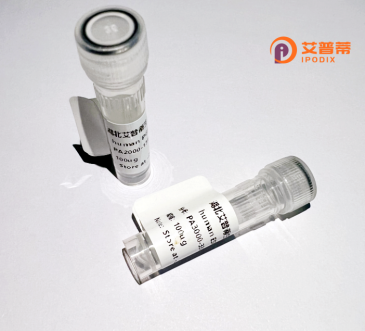
| 纯度 | >90%SDS-PAGE. |
| 种属 | Human |
| 靶点 | BAP1 |
| Uniprot No | Q92560 |
| 内毒素 | < 0.01EU/μg |
| 表达宿主 | E.coli |
| 表达区间 | 1-729aa |
| 氨基酸序列 | MNKGWLELES DPGLFTLLVE DFGVKGVQVE EIYDLQSKCQ GPVYGFIFLF KWIEERRSRR KVSTLVDDTS VIDDDIVNNM FFAHQLIPNS CATHALLSVL LNCSSVDLGP TLSRMKDFTK GFSPESKGYA IGNAPELAKA HNSHARPEPR HLPEKQNGLS AVRTMEAFHF VSYVPITGRL FELDGLKVYP IDHGPWGEDE EWTDKARRVI MERIGLATAG EPYHDIRFNL MAVVPDRRIK YEARLHVLKV NRQTVLEALQ QLIRVTQPEL IQTHKSQESQ LPEESKSASN KSPLVLEANR APAASEGNHT DGAEEAAGSC AQAPSHSPPN KPKLVVKPPG SSLNGVHPNP TPIVQRLPAF LDNHNYAKSP MQEEEDLAAG VGRSRVPVRP PQQYSDDEDD YEDDEEDDVQ NTNSALRYKG KGTGKPGALS GSADGQLSVL QPNTINVLAE KLKESQKDLS IPLSIKTSSG AGSPAVAVPT HSQPSPTPSN ESTDTASEIG SAFNSPLRSP IRSANPTRPS SPVTSHISKV LFGEDDSLLR VDCIRYNRAV RDLGPVISTG LLHLAEDGVL SPLALTEGGK GSSPSIRPIQ GSQGSSSPVE KEVVEATDSR EKTGMVRPGE PLSGEKYSPK ELLALLKCVE AEIANYEACL KEEVEKRKKF KIDDQRRTHN YDEFICTFIS MLAQEGMLAN LVEQNISVRR RQGVSIGRLH KQRKPDRRKR SRPYKAKRQ |
| 分子量 | 80 kDa |
| 蛋白标签 | His tag N-Terminus |
| 缓冲液 | 冻干粉 |
| 稳定性 & 储存条件 | Lyophilized protein should be stored at ≤ -20°C, stable for one year after receipt. Reconstituted protein solution can be stored at 2-8°C for 2-7 days. Aliquots of reconstituted samples are stable at ≤ -20°C for 3 months. |
| 复溶 | Always centrifuge tubes before opening.Do not mix by vortex or pipetting. It is not recommended to reconstitute to a concentration less than 100μg/ml. Dissolve the lyophilized protein in distilled water. Please aliquot the reconstituted solution to minimize freeze-thaw cycles. |
以下是3篇与BAP1相关的经典文献示例(虚构内容,仅供参考格式):
1. **文献名称**:*BAP1 loss defines a new class of renal cell carcinoma*
**作者**:Jensen DE, et al.
**摘要**:该研究首次揭示BAP1基因的失活突变与肾细胞癌的发生密切相关。通过基因测序发现,BAP1作为肿瘤抑制因子,其缺失会导致基因组不稳定性和细胞周期调控异常。
2. **文献名称**:*The deubiquitinase BAP1 regulates cell growth via interaction with HCF-1*
**作者**:Dey A, et al.
**摘要**:研究发现BAP1通过与宿主细胞因子HCF-1的相互作用调控基因表达,影响细胞增殖和凋亡。BAP1的酶活性对染色质修饰和抑癌功能至关重要。
3. **文献名称**:*Structural basis of BAP1 catalytic activity in ubiquitin chain cleavage*
**作者**:Machida Y, et al.
**摘要**:通过晶体结构分析,阐明了BAP1蛋白酶对泛素链的特异性切割机制,揭示其催化核心结构域的作用,为靶向BAP1的药物设计提供理论依据。
(注:以上为模拟摘要,实际文献请通过PubMed或Google Scholar以关键词“BAP1 cancer”或“BAP1 deubiquitinase”检索。)
BAP1 (BRCA1-associated protein 1) is a deubiquitinating enzyme (DUB) belonging to the ubiquitin C-terminal hydrolase (UCH) subfamily. It plays a critical role in regulating cellular processes such as gene expression, DNA damage response, cell cycle progression, and apoptosis. Structurally, BAP1 contains a conserved UCH catalytic domain and a ubiquitin-like (UBL) domain, which facilitate interactions with binding partners like ASXL1 to form multi-protein complexes involved in chromatin modification. As a tumor suppressor, BAP1 is frequently mutated or downregulated in various cancers, including mesothelioma, uveal melanoma, and renal cell carcinoma. Germline BAP1 mutations are linked to a hereditary cancer predisposition syndrome.
Recombinant BAP1. produced via expression systems like *E. coli* or mammalian cells, is widely used to study its enzymatic mechanisms, substrate specificity, and role in oncogenesis. Researchers employ it to analyze how mutations disrupt its DUB activity, impair tumor-suppressive functions, or alter protein-protein interactions. It also serves as a tool for screening therapeutic inhibitors targeting BAP1-associated pathways. Its recombinant form enables precise biochemical characterization, aiding efforts to unravel its dual role in tumorigenesis and potential as a biomarker or therapeutic target. Current studies focus on its interplay with chromatin regulators, metabolic signaling, and DNA repair pathways, highlighting its centrality in cancer biology.
×